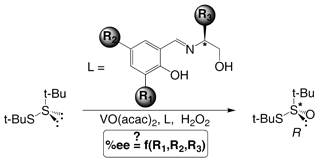A computational study with the IMOMM(Becke3LYP:MM3) method is carried out on the mechanism of the enantioselective reaction of complex V(O)(L)(OOH), L= bulky tridentate Schiff base, and bis(tert-butyl) disulfide. The reaction with a given L ligand A is first systematically studied: different conformers of the catalyst are optimized, and the large number of associated transition states are systematically searched. The study is then extended to the geometry optimization of selected transition states associated to other ligands B, C, and D, similar to A but differing in the nature of certain substituents R1, R2, R3. The experimental trends in selectivity for catalysts based on ligands A to D are faithfully reproduced by the calculations. Analysis of the computational results leads finally to the formulation of a simple model that can explain one of the most remarkable aspect of this reaction, namely the large effect on enantioselectivity of ligands seemingly far from each other in the catalyst.
